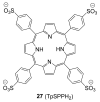Functions and Inhibition of Galectin-7, an Emerging Target in Cellular Pathophysiology
- PMID: 34827718
- PMCID: PMC8615947
- DOI: 10.3390/biom11111720
Functions and Inhibition of Galectin-7, an Emerging Target in Cellular Pathophysiology
Abstract
Galectin-7 is a soluble unglycosylated lectin that is able to bind specifically to β-galactosides. It has been described to be involved in apoptosis, proliferation and differentiation, but also in cell adhesion and migration. Several disorders and diseases are discussed by covering the aforementioned biological processes. Structural features of galectin-7 are discussed as well as targeting the protein intracellularly or extracellularly. The exact molecular mechanisms that lie behind many biological processes involving galectin-7 are not known. It is therefore useful to come up with chemical probes or tools in order to obtain knowledge of the physiological processes. The objective of this review is to summarize the roles and functions of galectin-7 in the human body, providing reasons why it is necessary to design inhibitors for galectin-7, to give the reader structural insights and describe its current inhibitors.
Keywords: apoptosis; epithelial tissues; galectin-7; inhibitors; targeting.
Conflict of interest statement
The author declares no conflict of interest.
Figures










Similar articles
-
Galectin-7 in Epithelial Homeostasis and Carcinomas.Int J Mol Sci. 2017 Dec 19;18(12):2760. doi: 10.3390/ijms18122760. Int J Mol Sci. 2017. PMID: 29257082 Free PMC article. Review.
-
Galectins: novel anti-inflammatory drug targets.Expert Opin Ther Targets. 2002 Aug;6(4):461-8. doi: 10.1517/14728222.6.4.461. Expert Opin Ther Targets. 2002. PMID: 16353421 Review.
-
Enzymatic synthesis of non-natural trisaccharides and galactosides; Insights of their interaction with galectins as a function of their structure.Carbohydr Res. 2019 Jan 15;472:1-15. doi: 10.1016/j.carres.2018.10.011. Epub 2018 Nov 3. Carbohydr Res. 2019. PMID: 30428394
-
Emerging role of alpha2,6-sialic acid as a negative regulator of galectin binding and function.J Biol Chem. 2011 Feb 25;286(8):5935-41. doi: 10.1074/jbc.R110.191429. Epub 2010 Dec 20. J Biol Chem. 2011. PMID: 21173156 Free PMC article. Review.
-
Placental galectins: a subfamily of galectins lose the ability to bind β-galactosides with new structural features†.Biol Reprod. 2023 Dec 11;109(6):799-811. doi: 10.1093/biolre/ioad114. Biol Reprod. 2023. PMID: 37672213 Review.
Cited by
-
Galectin functions in cancer-associated inflammation and thrombosis.Front Cardiovasc Med. 2023 Feb 17;10:1052959. doi: 10.3389/fcvm.2023.1052959. eCollection 2023. Front Cardiovasc Med. 2023. PMID: 36873388 Free PMC article. Review.
-
Development of Galectin-7-Specific Nanobodies: Implications for Immunotherapy and Molecular Imaging in Cancer.J Med Chem. 2025 Apr 24;68(8):8484-8496. doi: 10.1021/acs.jmedchem.5c00071. Epub 2025 Apr 10. J Med Chem. 2025. PMID: 40208951 Free PMC article.
-
Galectins as Master Regulators of Gastric Cancer Progression.Cells. 2025 Jul 16;14(14):1090. doi: 10.3390/cells14141090. Cells. 2025. PMID: 40710343 Free PMC article. Review.
-
Galectin Family Members: Emerging Novel Targets for Lymphoma Therapy?Front Oncol. 2022 May 23;12:889034. doi: 10.3389/fonc.2022.889034. eCollection 2022. Front Oncol. 2022. PMID: 35677161 Free PMC article. Review.
-
Multifaceted roles of Galectins: from carbohydrate binding to targeted cancer therapy.Biomark Res. 2025 Mar 25;13(1):49. doi: 10.1186/s40364-025-00759-1. Biomark Res. 2025. PMID: 40134029 Free PMC article. Review.
References
-
- Varki A., Cummings R.D., Esko J.D., Stanley P., Hart G.W., Aebi M., Darvill A.G., Kinoshita T., Packer N.H., Prestegard J.H., et al. Essentials of Glycobiology. 3rd ed. Cold Spring Harbor Laboratory Press; New York, NY, USA: 2017. - PubMed
-
- Si Y., Yao Y., Jaramillo Ayala G., Li X., Han Q., Zhang W., Xu X., Tai G., Mayo K.H., Zhou Y., et al. Human galectin-16 has a pseudo ligand binding site and plays a role in regulating c-Rel-mediated lymphocyte activity. Biochim. Biophys. Acta Gen. Subj. 2021;1865:129755. doi: 10.1016/j.bbagen.2020.129755. - DOI - PubMed
Publication types
MeSH terms
Substances
LinkOut - more resources
Full Text Sources
Other Literature Sources

